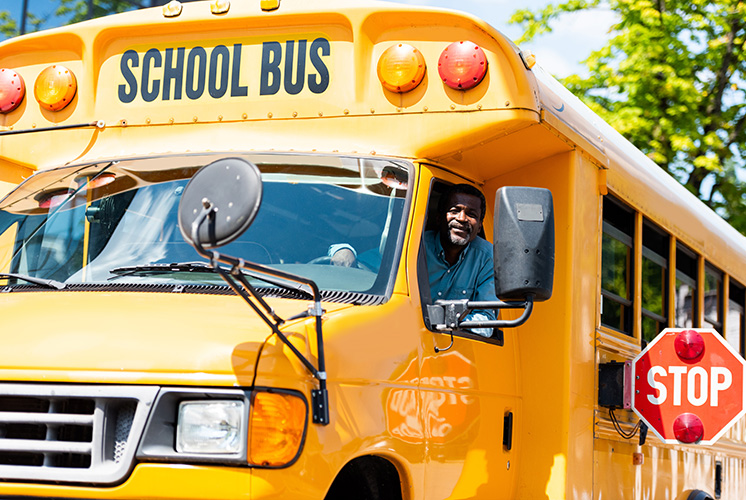 Safety is a primary consideration when transporting children. Programs are required to practice bus safety education procedures with children and provide reinforcement (45 CFR §1303.74). The following information reviews the role of Head Start staff in helping children learn socialization skills and develop safe behaviors on the bus.
Safety is a primary consideration when transporting children. Programs are required to practice bus safety education procedures with children and provide reinforcement (45 CFR §1303.74). The following information reviews the role of Head Start staff in helping children learn socialization skills and develop safe behaviors on the bus.
Teach Safety Skills
Transportation staff can reduce time spent on discipline problems by prioritizing safety procedures. As children gain a sense of self-control, they increase their ability to regulate their own behavior. Routines and transitions should occur in a timely, predictable, and unrushed manner (45 CFR §§1302.31(e)(3) and 1303.74(a)). Important lessons include how and when to board the vehicle, take a seat, leave a seat, exit the vehicle, and participate in a bus evacuation drill. Help children understand the words for objects in the bus, such as aisle, door, emergency exit, handrail, restraint system, seat, seat belt, step, and window.
Routines
Staff, like bus drivers and bus monitors, can introduce procedures and help children practice it regularly. They can teach children to pay attention to cues, find their assigned seat, buckle their seat belt/restraint system, follow directions, and participate in songs or games. They should encourage self-control appropriate to the attention span of each child.
For example, staff can remind everyone to keep on their restraint system when the bus is moving and to look at their neighbor to see that everyone's nicely buckled up. Through daily routines, all staff should express positive attitudes about the child's ability to learn bus procedures.
Reinforcing Good Behavior
Give appropriate rewards for good behavior, such as praise, a smile, a high five, pat, or handshake. For example, "Hector, you found your seat belt and buckled up. Nice work!" Dialogue that conveys and encourages positive behaviors helps children develop a sense of accomplishment. For example, "Remember to say, 'Excuse me' when you bump into a person." Also, "I like the way Innocente is sitting. She has her restraint system buckled."
Working with Families
Transportation staff can collaborate with parents to make the bus ride an enjoyable experience (45 CFR §1302.90(d)). It is important to understand how parents communicate with their children, especially in different communities. When transportation staff understand the various parenting styles, they can tailor their approach on the bus. Together, parents and staff can support a child's learning about personal space, expressing emotions, and practicing self-control.
Additionally, staff must complete vehicle evacuation drills, at least three times per year, and educate children on vehicle danger zones, pedestrian safety, boarding the bus, and safe riding behavior (45 CFR §1303.74).
Dealing with Challenging Behaviors on Buses
Even with safety practices in place, children may display challenging behavior. These behaviors may reflect feelings of fear, insecurity, and anxiety due to traveling. Examples of challenging behaviors include yelling, biting, scratching, kicking, hitting, fighting, bullying, and name calling. During these times, children often find that they are unable to solve problems. They may struggle to communicate effectively or respect others.
Delivery
Body language, personality, and the attitude of an adult on the bus can influence the expectations of children both positively and negatively. Be calm in all interactions. Hearing a harsh tone or loud adult voice may frighten children. Speak clearly and consistently about expectations. Use the child's name when speaking to that individual.
Expectations
Children exposed to unrealistic expectations or confusing situations may exhibit behaviors that challenge adults and other children. Therefore, adults need to observe children and anticipate their needs. Adults may help children avoid challenging behavior by using clear and consistent language and setting realistic expectations (45 CFR §1302.45(b)).
Discipline
The bus monitor should manage challenging behavior by continually monitoring all children. They can simplify the need to discipline by addressing one behavior to all students by saying things like, "Everyone should use their quiet voices on the bus."
Staff can encourage respect for the feelings and rights of others by saying things like, "We need to share the bus seats with our neighbor." Encourage children with coaching language. For example, "I would like everyone to walk down the aisle. Let's count the steps to your seat."
Never discipline by isolating a child. Do not reward or punish with food or deny the basic needs of a child. Give children immediate feedback on their behavior. For example, "What a nice line! Everyone is standing without pushing," or "Jingyu, you listened and sat down. Good job." The need for discipline arises when children fail to understand the procedures. It is important to deal with the unwanted behavior while maintaining the child's dignity. Repeat the desired procedure and encourage children to practice it.
Read more:
Resource Type: Article
National Centers: Program Management and Fiscal Operations
Program Option: Center-Based Option
Audience: Transportation Staff
Last Updated: February 12, 2025
